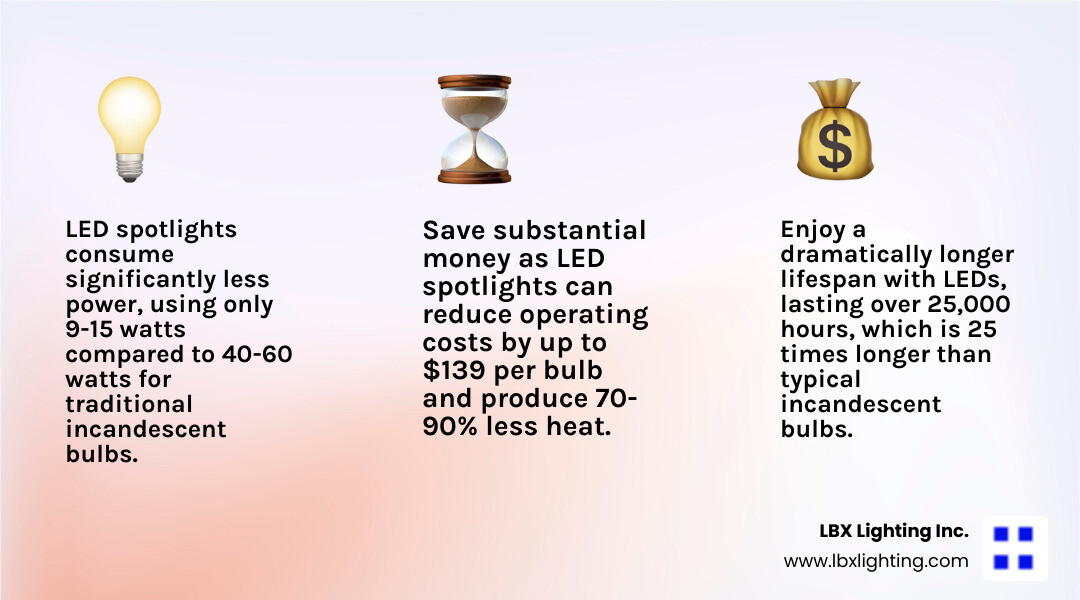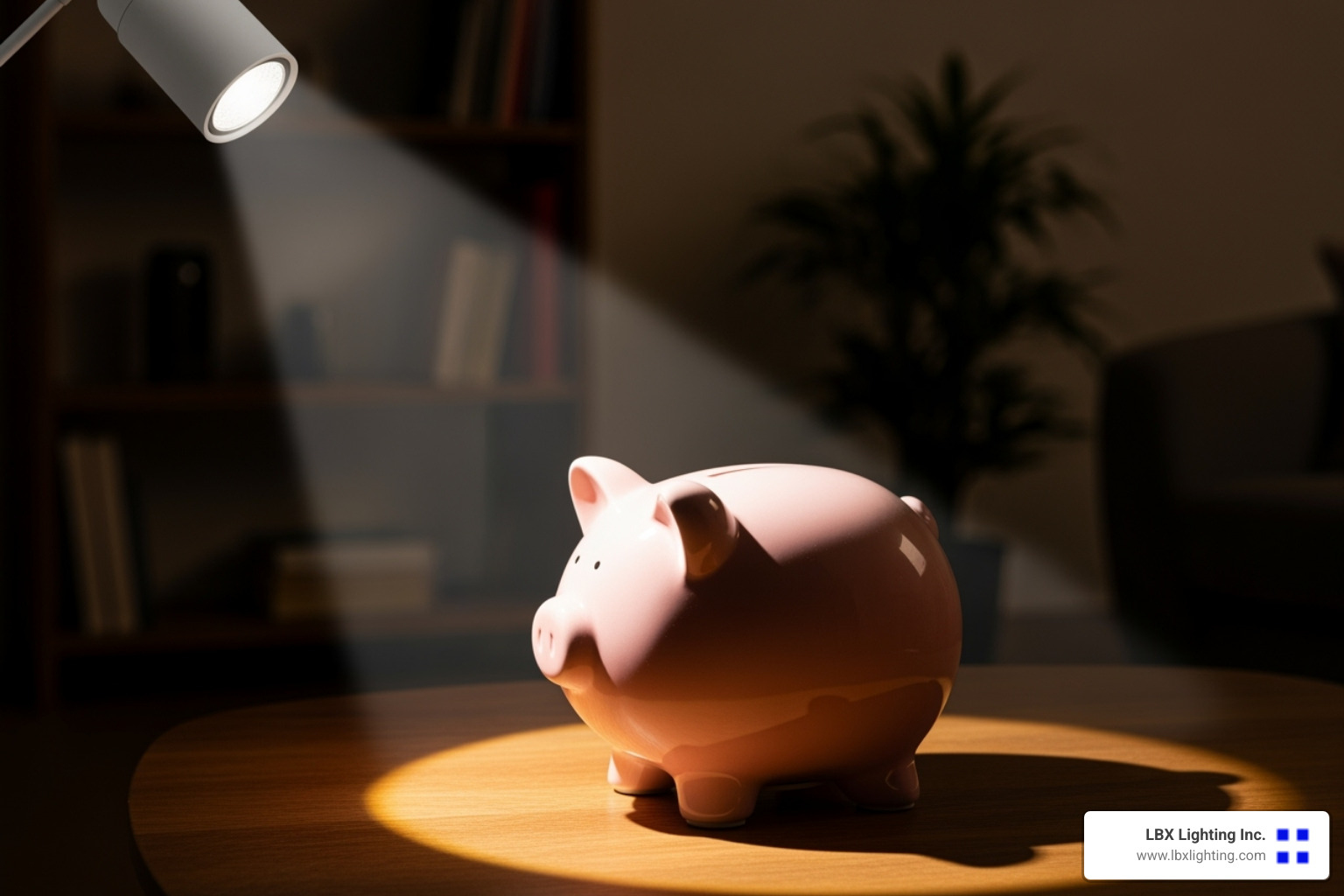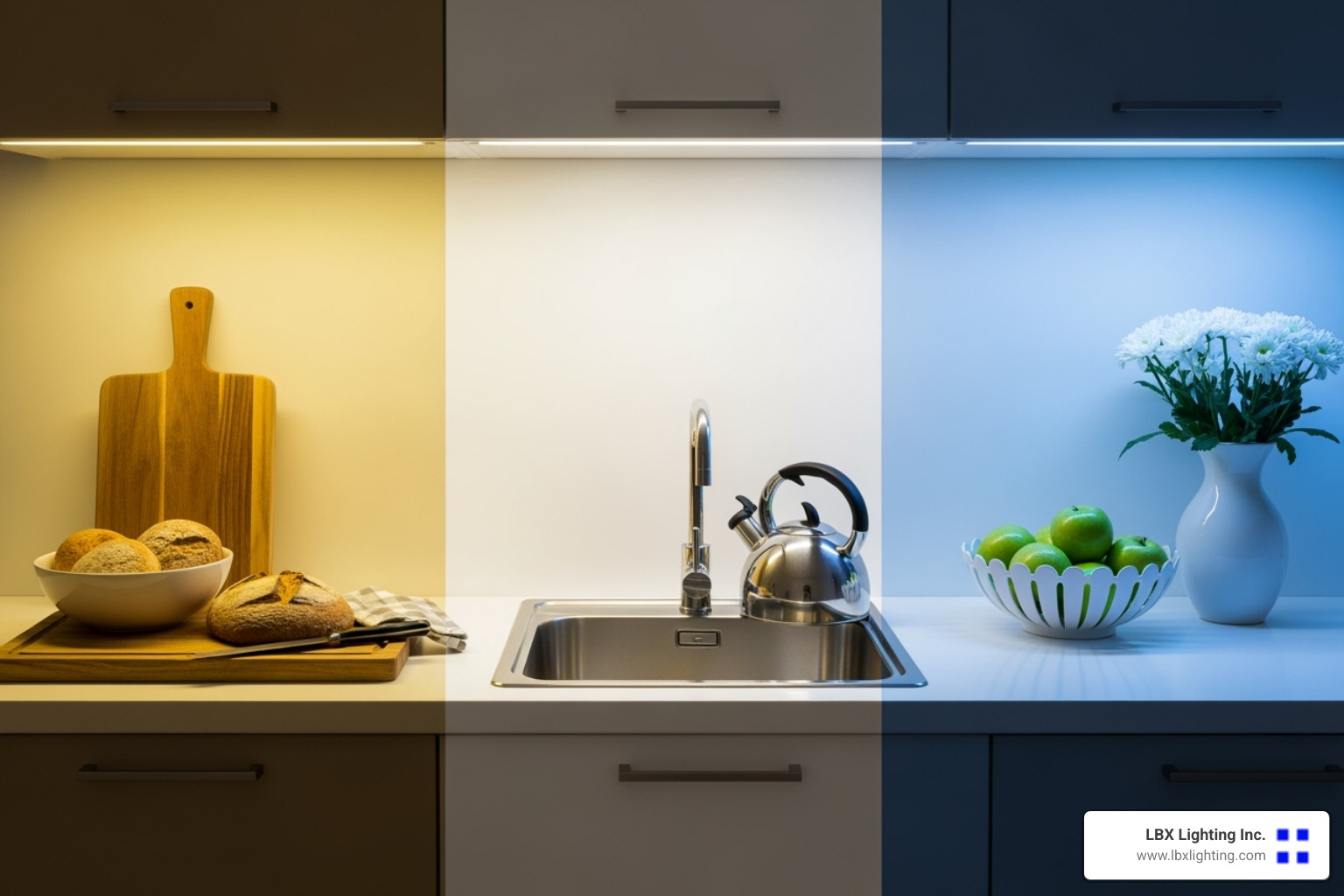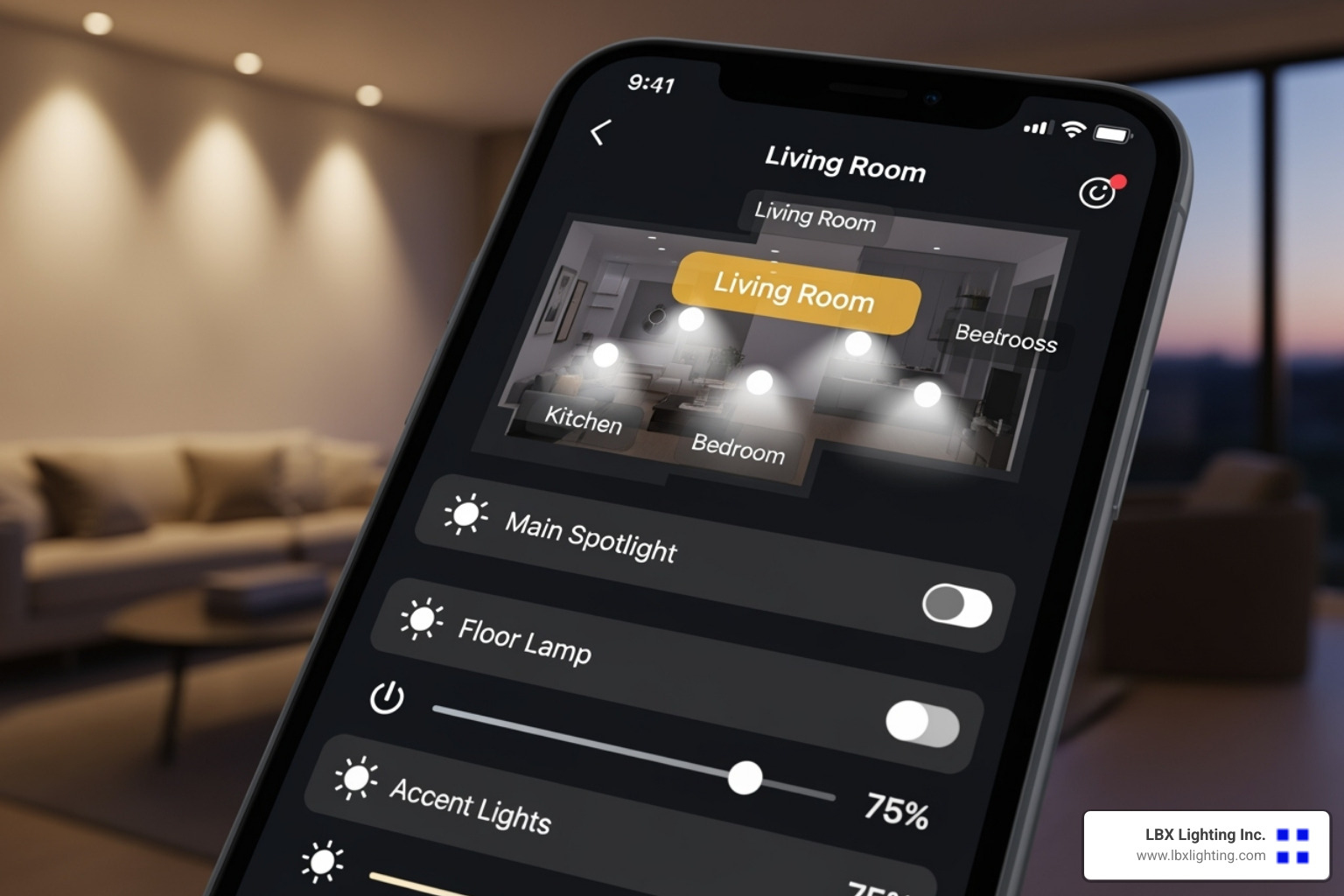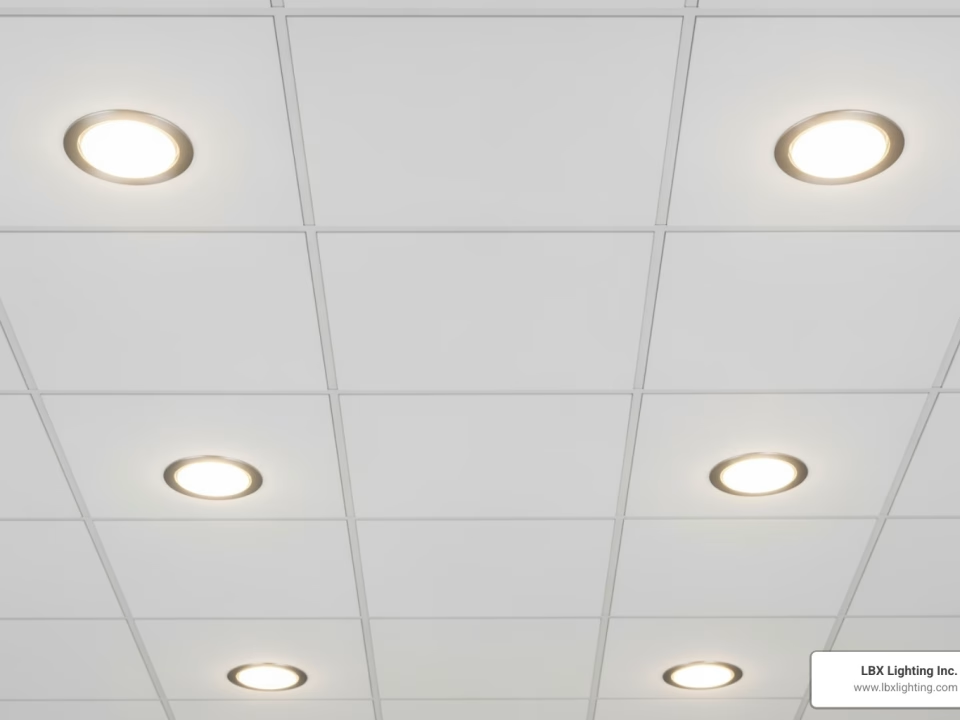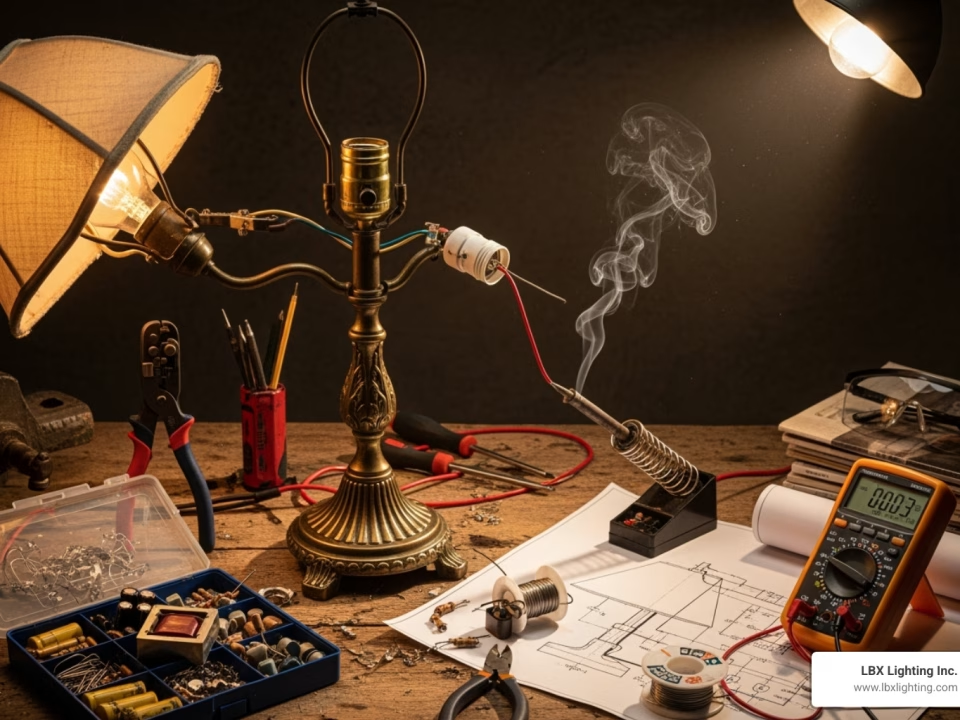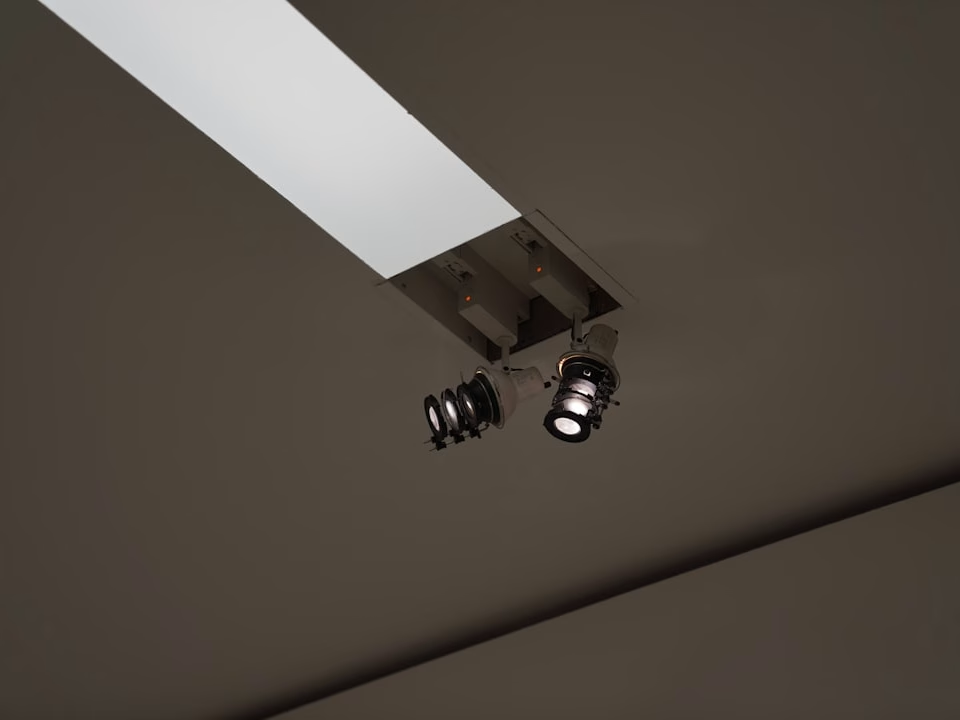
Top Lighting Control Systems: Reviews and Buyer’s Guide
September 29, 2025
Sparkle and Shine: Expert Christmas Light Installation in Houston
October 1, 2025
Why Energy Efficient Spotlight Bulbs Are the Smart Choice for Every Home
Energy efficient spotlight bulbs use up to 90% less energy than traditional incandescent bulbs while lasting 15 to 25 times longer. Here’s what you need to know:
- LED spotlights are the most efficient option, using only 9-15 watts compared to 40-60 watts for incandescent
- Lifespan: 25,000+ hours (10-15 years) vs. 1,000 hours for traditional bulbs
- Cost savings: Up to $75 saved per bulb over its lifetime
- Common types: GU10, PAR20, PAR30, PAR38, and MR16 for different fixtures
- Features: Dimmable options, various color temperatures, and smart capabilities available
Whether you’re lighting a kitchen, highlighting artwork, or creating ambiance in a living room, energy efficient spotlight bulbs deliver focused light exactly where you need it while dramatically cutting your electricity bills.
The numbers tell the whole story. LED spotlight bulbs can pay for themselves in energy savings within eight months, and they produce 70-90% less heat than traditional options. This means lower cooling costs and reduced fire risk in your home.
I’m Michael Eftekhar, and for over 30 years, I’ve helped Houston homeowners and designers find the perfect lighting solutions, including energy efficient spotlight bulbs that deliver both performance and savings. My experience has shown me that making the switch to efficient spotlights is one of the easiest upgrades that provides immediate benefits.
The Unbeatable Benefits of Switching to Energy-Efficient Spotlight Bulbs
Picture this: your favorite artwork gets the perfect illumination it deserves, your kitchen counters gleam under focused light, and your electricity bill drops by $75 per bulb over its lifetime. That’s the everyday magic of energy efficient spotlight bulbs – they’re not just lighting up your space, they’re brightening your financial future too.
Here’s what blew my mind when I first finded LED spotlights: traditional incandescent bulbs waste over 95% of their energy as heat. Essentially, you’re paying for a tiny, expensive heater that happens to give off some light. Energy efficient spotlight bulbs flip this equation completely, using up to 90% less energy to produce the same beautiful, focused light.
The numbers speak for themselves. Replace just one old spotlight with an LED, and you could save $75 in electricity costs over that single bulb’s lifetime. When you consider that LED spotlights last 25 times longer than traditional bulbs – we’re talking 25,000 hours or about 10 to 15 years – those savings really start adding up.
But the benefits go way beyond your monthly electric bill. These bulbs produce 70-90% less heat, which means your air conditioning doesn’t have to work as hard during Houston’s scorching summers. Your home stays cooler, your cooling costs drop, and you’re not constantly replacing burned-out bulbs.
The environmental impact is equally impressive. Every energy efficient spotlight bulb you install reduces your carbon footprint significantly. Less energy consumption means fewer greenhouse gas emissions, and the extended lifespan means less waste heading to landfills. It’s one of those rare situations where doing good for your wallet also does good for the planet.
Want to explore more ways your lighting choices can make a positive impact? Check out our Eco-Friendly Lighting Solutions for additional options.
Long-Term Financial and Environmental Wins
The upfront cost of an LED spotlight might be higher than a traditional bulb, but here’s where the math gets exciting. The payback period is remarkably short – most LED spotlights pay for themselves through energy savings in less than eight months.
Think about it this way: it costs about $30 to run an LED spotlight for 25,000 hours, compared to $169 for an incandescent bulb over the same period. That’s a $139 difference per bulb! The U.S. Department of Energy data on LED longevity confirms that LEDs last 30 times longer than incandescent bulbs and 3 to 5 times longer than CFLs.
The reduced replacement frequency is a game-changer for busy homeowners. No more frequent ladder climbing or emergency bulb runs to the store. Less frequent replacements also mean less landfill waste – a single LED can prevent dozens of traditional bulbs from ending up in the trash.
Here’s a perspective that might surprise you: if every American home replaced just one spotlight with an ENERGY STAR LED, we’d save about $580 million in energy costs annually and prevent billions of pounds of greenhouse gas reduction. Your small lighting decision contributes to a massive positive change.
Improved Safety and Durability
Safety was one of my biggest concerns when recommending lighting for family homes, and energy efficient spotlight bulbs excel here too. The cooler operation of LEDs dramatically reduces fire risk – no more worrying about bulbs getting dangerously hot in enclosed fixtures or near curtains and fabrics.
The solid-state construction of LEDs means no delicate filaments that can break with vibration or handling. They’re naturally shatter resistant, making them perfect for homes with kids or high-traffic areas. I’ve seen too many traditional bulbs break during installation – LEDs are much more forgiving.
Perhaps most importantly, LEDs contain no toxic materials like mercury. Unlike CFLs that require special disposal procedures, you can handle and dispose of LEDs without health concerns. This makes them safer for your family and eliminates the worry about mercury contamination if a bulb accidentally breaks.
The combination of lower heat output, durable construction, and non-toxic materials makes energy efficient spotlight bulbs the clear choice for any safety-conscious homeowner.
Decoding the Technology: LED vs. Other Spotlight Options
When you’re shopping for energy efficient spotlight bulbs, you’ll quickly find that LED technology dominates the market – and for good reason. But you might still encounter other options like CFL (Compact Fluorescent Lamp) and halogen spotlights, so let’s break down how these technologies compare.
The differences between these lighting technologies are pretty dramatic when you look at the numbers. LED spotlights use up to 90% less energy than traditional incandescent bulbs, while CFLs offer about 75% energy savings and halogens only manage a modest 28% improvement. But efficiency is just the beginning of the story.
When it comes to lifespan, LEDs are in a league of their own. A quality LED spotlight can last 25,000 to 50,000 hours – that’s roughly 15 to 25 times longer than an incandescent bulb. CFLs fall somewhere in the middle at 8,000 to 10,000 hours, while halogens typically burn out after just 2,000 to 3,000 hours.
Heat output is another crucial factor, especially for spotlights that often run for extended periods. LEDs produce 70-90% less heat than incandescent bulbs, making them much safer and more comfortable. CFLs also run relatively cool, but halogens still generate significant heat – enough to make a room noticeably warmer.
The dimmability comparison reveals some interesting differences too. LEDs offer excellent dimming performance when paired with compatible dimmers, while CFLs can be problematic and require specific CFL-compatible dimmers. Halogens dim smoothly, much like their incandescent cousins.
From an environmental perspective, LEDs are completely mercury-free and fully recyclable. CFLs contain small amounts of mercury and require special disposal, while halogens are mercury-free but their shorter lifespan and higher energy consumption make them less eco-friendly overall.
Why LEDs Reign Supreme for Spotlights
There’s something magical about flipping a switch and getting instant, full brightness – and that’s exactly what LED spotlights deliver. Unlike CFLs that need time to warm up to full output, LEDs give you maximum light the moment you turn them on. This instant-on feature makes them perfect for security lighting, task areas, or anywhere you need immediate illumination.
The dimming capabilities of modern LEDs have come a long way from the early days when they flickered or hummed with certain dimmers. Today’s LED spotlights offer incredibly smooth dimming, and many even get warmer in color temperature as they dim – just like old incandescent bulbs. This gives you complete control over both brightness and ambiance.
Mercury-free construction means you never have to worry about hazardous materials in your home or special disposal requirements. It’s one less thing to think about, and it makes LEDs much safer for families with children.
LEDs excel at focused light direction because of their inherent design. Unlike traditional bulbs that scatter light in all directions, LEDs can be engineered to direct light precisely where you want it. This makes them incredibly efficient for spotlight applications where you want to highlight specific areas without wasting light.
The color rendering quality of LEDs has improved dramatically over the years. High-quality LED spotlights now offer excellent Color Rendering Index (CRI) ratings of 80 or higher, meaning they show colors naturally and vibrantly – crucial for accent lighting or retail displays.
What About CFL and Halogen Spotlights?
While CFLs were once considered the energy-efficient alternative to incandescents, they have some quirks that make them less than ideal for spotlight applications. The most noticeable issue is their warm-up time – CFLs can take anywhere from 30 seconds to several minutes to reach full brightness. This delay can be particularly frustrating when you’re trying to illuminate a workspace or highlight artwork.
More importantly, CFLs contain mercury – not a lot, but enough to require special handling and disposal. You can’t just toss a burned-out CFL in the regular trash; it needs to be taken to a recycling center that handles hazardous materials.
Halogen spotlights are essentially improved incandescent bulbs – they’re brighter and slightly more efficient than old-school incandescents, but they still work by heating a filament until it glows. This means they still waste a lot of energy as heat, making them less comfortable in living spaces and potentially increasing your cooling costs.
The shorter lifespan of halogens also means you’ll be replacing them much more frequently than LEDs. While they might cost less upfront, the combination of higher energy use and frequent replacements makes them more expensive in the long run.
When it comes time to dispose of old bulbs, proper recycling is important. CFLs especially need special handling due to their mercury content. You can find a recycling location via Product Care to ensure your old bulbs are disposed of safely and responsibly. The good news? Once you switch to LEDs, you won’t need to worry about these disposal complexities for many years to come.
How to Choose the Perfect Energy-Efficient Spotlight Bulb
Finding the perfect energy efficient spotlight bulb is like choosing the right pair of shoes – it needs to fit your space perfectly and serve its purpose beautifully. Whether you’re illuminating your kitchen counters or creating that perfect reading nook, the right bulb makes all the difference.
The first step is always reading the label carefully. Look for that golden ENERGY STAR® certification – it’s your guarantee that the bulb has been independently tested for quality, energy savings, and environmental performance. Think of it as a seal of approval from the experts.
Next, make sure the bulb actually matches your fixture. This might sound obvious, but you’d be surprised how many people grab a bulb only to find it doesn’t fit! Check the base type, size, and whether your fixture is enclosed (some LEDs need special ratings for enclosed spaces).
Finally, consider your application needs. Are you highlighting artwork? You’ll want different specifications than if you’re lighting a work area. The beauty of modern energy efficient spotlight bulbs is that there’s truly an option for every need. For comprehensive guidance on selecting the perfect lighting for your home, our Residential Lighting Solutions page offers detailed insights.
Lumens vs. Watts: Understanding Brightness and Efficiency
Here’s where things get interesting – and where many people get confused. For decades, we’ve thought “more watts = brighter light.” A 60-watt bulb was obviously brighter than a 40-watt one, right? Well, that old thinking needs to go out the window with those energy-guzzling incandescents.
Lumens are what actually tell you how bright a bulb is. Think of lumens as the light you see, while watts are simply the electricity the bulb uses to create that light. The magic of LEDs is their incredible efficacy – they produce tons of light (lumens) while sipping very little electricity (watts).
Here’s your cheat sheet for making the switch: A traditional 40-watt incandescent produces about 450 lumens but an LED gives you the same brightness using only 9-10 watts. A 60-watt incandescent’s 800 lumens can be matched by an LED using just 11-12 watts. For the brightness of a 75-watt incandescent (1100 lumens), you’ll use only 14-15 watts with an LED. And that bright 100-watt incandescent producing 1600 lumens? An LED does it with just 18-20 watts.
It’s like getting a luxury car that runs on a fraction of the gas – same performance, massive savings.
Finding Your Perfect Glow: Color Temperature and CRI
Light isn’t just about brightness – it’s about mood, comfort, and how things look in your space. Color temperature, measured in Kelvin, is your secret weapon for creating the perfect ambiance.
Warm white light (2700K-3000K) gives you that cozy, yellowish glow we associate with home. It’s like a gentle sunset in your living room – perfect for creating ambiance where you want to relax and unwind. Most people choose this for bedrooms, living rooms, and dining areas.
Neutral white (3500K-4100K) strikes the perfect balance. It’s not too yellow, not too blue – just right for spaces where you need good visibility without feeling like you’re in a hospital. Kitchens and bathrooms love this balanced approach.
Cool white or daylight (5000K-6500K) brings that crisp, energizing light that mimics natural daylight. It’s fantastic for task lighting in garages, workshops, or anywhere you need to see details clearly.
But there’s another piece to the puzzle: Color Rendering Index (CRI). This measures how accurately your bulb shows the true natural colors of objects. A high CRI (80-100) means your red tomatoes look red, not muddy brown. For spotlights highlighting artwork or anywhere color accuracy matters, don’t settle for anything less than CRI 80.
Directing the Light: Beam Angle and Common Bulb Types for energy efficient spotlight bulbs
The beauty of spotlights lies in their ability to direct light exactly where you want it. Beam angle is the key to this precision – it determines whether you get a tight spotlight or a broader flood of light.
Narrow beam angles (10-25 degrees) create that dramatic focused light direction perfect for highlighting a painting or architectural detail. Think of it as a flashlight beam – precise and purposeful. Wider beam angles (35-60 degrees) spread the light out more, making them ideal for general area lighting or washing a wall with gentle illumination.
When it comes to bulb types, each has its perfect place. GU10 base bulbs use that handy twist-and-lock design with two pins – you’ll find them in most modern track lighting and recessed lighting setups. They’re incredibly popular because they’re easy to install and come in dimmable versions.
The PAR series offers three main sizes for different needs. PAR20 bulbs are the compact choice for smaller recessed cans and track lights. PAR30 bulbs hit the sweet spot for most residential applications – versatile enough for indoor recessed lighting and outdoor flood applications. PAR38 bulbs bring the big guns for larger spaces, outdoor security lighting, or anywhere you need serious illumination power.
MR16 base bulbs are the small but mighty option with their two-pin design. They’re perfect for discreet accent lighting, display cases, or landscape applications where you want light without the bulb being obvious.
Whether you’re updating existing recessed lighting or installing new track lighting, understanding these options helps you choose the perfect energy efficient spotlight bulbs for your specific needs. Our Expert Lighting Tips page dives even deeper into making the right choices for your space.
Smart Spotlights and Ideal Applications
The lighting world has transformed dramatically, and energy efficient spotlight bulbs are at the forefront of this smart revolution! When you add intelligent features to your spotlights, you’re not just getting a cool tech upgrade – you’re open uping powerful new ways to save energy and make your life more convenient.
Picture this: you’re heading to bed and instead of walking around the house checking every light, you simply say “Alexa, turn off all the spotlights.” Or maybe you want your outdoor security lights to automatically brighten when someone approaches your front door. This isn’t science fiction – it’s what smart home integration brings to your lighting today.
Modern smart spotlights connect seamlessly to your home’s Wi-Fi network, opening up incredible possibilities for improved functionality. Voice control lets you adjust your kitchen spotlights while your hands are busy cooking. Scheduling means your landscape spotlights can automatically turn on at sunset and off at sunrise, providing security without you having to remember. And when you pair spotlights with motion sensors, you get convenience lighting in hallways or improved security outdoors – some energy-efficient bulbs even come with built-in motion detection.
These aren’t just fancy gadgets; they’re practical tools that make your lighting work smarter, not harder. To explore how smart lighting can completely transform your space, check out our More info about Innovative Lighting Solutions.
Where to Use Energy-Efficient Spotlight Bulbs for Maximum Impact
While energy efficient spotlight bulbs work wonderfully almost anywhere, certain applications really let them show off their strengths. Their precise, focused light combined with incredible energy savings makes them perfect choices for specific areas around your home.
In kitchens, these bulbs excel at task lighting over countertops, islands, and sinks. High CRI LED spotlights ensure your food prep looks natural and appealing – because nobody wants their fresh vegetables looking sickly under poor lighting! Bathrooms benefit from focused illumination around mirrors for grooming tasks, giving you the clear, bright light you need without harsh shadows.
For art galleries and retail displays, spotlights with high color rendering capabilities precisely highlight artwork or merchandise, drawing attention exactly where you want it. The focused beam eliminates wasteful light spillage while making colors pop naturally. Landscape lighting applications are where these bulbs really shine outdoors – illuminating pathways, architectural features, or garden elements while consuming minimal power and providing both beauty and security.
Homes with high ceilings present unique challenges that spotlights handle beautifully. Rather than flooding the entire space with diffused light that gets lost in the height, spotlights with higher lumen outputs (400-600 lumens) direct light precisely where it’s needed. We specialize in these challenging applications with our LED Lighting for High Ceilings solutions.
Accent lighting remains the classic spotlight application – emphasizing architectural details, highlighting bookcases, or creating visual interest in any area you want to showcase. Whether you’re using track lighting systems that let you reposition and aim multiple spotlights as your needs change, or recessed lighting that integrates seamlessly into your ceiling for a clean, modern look, energy-efficient spotlights deliver focused illumination exactly where you want it.
Opening up Extra Savings with Smart Features
Smart features aren’t just about impressing your friends with voice-controlled lights – they’re powerful money-saving tools that help you squeeze every bit of efficiency from your energy efficient spotlight bulbs.
Automated schedules eliminate one of the biggest energy wasters: lights accidentally left on when no one’s around. Program your spotlights to turn off automatically when you typically leave for work or go to bed, and you’ll see the difference in your electricity bill. Dimming capabilities do double duty – they create perfect ambiance while reducing energy consumption. Even dimming your lights by just 25% can lead to noticeable savings over time.
Geofencing technology uses your smartphone’s location to automatically manage your lighting. Your outdoor spotlights can turn on as you pull into the driveway and turn off after you leave, ensuring you never waste energy on empty spaces. Meanwhile, energy usage monitoring through smart lighting apps gives you real insights into your consumption patterns, helping you identify opportunities to save even more.
Perhaps the most practical feature is remote access. We’ve all had that moment – you’re already on the highway when you remember leaving the backyard spotlights on. With smart controls, you can turn them off from anywhere using your smartphone, preventing hours of wasted energy.
These intelligent features transform your lighting from a static system into a responsive, efficient partner that adapts to your lifestyle while maximizing your energy savings.
Frequently Asked Questions about Energy-Efficient Spotlights
Over my three decades helping Houston homeowners find the perfect lighting solutions, I’ve noticed that certain questions about energy efficient spotlight bulbs come up again and again. Let me share the answers to the most common ones, based on real conversations I’ve had with clients just like you.
How much money can I really save by switching to LED spotlights?
The savings are honestly quite impressive, and I love showing customers the math because it really drives the point home. When you switch to energy efficient spotlight bulbs, particularly LEDs, you’re looking at up to 90% less energy consumption compared to those old incandescent bulbs that have been burning holes in your wallet.
Here’s a real-world example that always gets people’s attention: Let’s say you run a bulb for 25,000 hours (which is the typical lifespan of an LED). An old incandescent would cost you about $169 in electricity over that time, while an LED would only cost around $30. That’s a whopping $139 in savings from just one bulb!
Now, think about this on a larger scale. The average home has about 30 light bulbs, and even if you only replace your most frequently used spotlights, those savings start adding up fast. Each LED spotlight can save you $75 or more over its lifetime when you factor in both the reduced electricity costs and the money you’ll save from not constantly buying replacement bulbs.
The beauty is that LEDs last 15 to 25 times longer than traditional bulbs, so you’re getting significant savings on two fronts. It’s like getting a bonus every month on your electricity bill, and who doesn’t love that?
Can I use an energy-efficient spotlight bulb in my existing fixture?
This is probably the question I hear most often, and I’m happy to say that in most cases, absolutely yes! The manufacturers have made it really easy for homeowners by designing these bulbs to fit right into your existing fixtures. No rewiring, no major renovations – just unscrew the old and screw in the new.
The key is making sure you’re getting the right base type. If your current spotlight has a GU10 base (those are the ones with two pins that twist and lock), then you’ll need a GU10 LED. If it’s a standard screw-in base like an E26, same principle applies. The PAR and MR16 bases work the same way.
However, there are a few things I always tell my clients to double-check. If your fixture is enclosed (like some of those recessed ceiling cans), make sure the LED bulb is specifically rated for enclosed fixtures. Heat can build up in those spaces, and not all LEDs are designed to handle it.
The other thing to watch out for is dimmer switch compatibility. Those old dimmer switches were designed for incandescent bulbs, and they don’t always play nice with LEDs. You might get flickering, buzzing, or the dimming just won’t work properly. If you want to dim your new LED spotlights, both the bulb and your dimmer need to be LED-compatible. We can definitely help you figure out which dimmers will work best with your new bulbs.
How do I properly dispose of old spotlight bulbs?
This is such an important question, and I’m glad people are asking it more often. The way you dispose of your old bulbs depends entirely on what type they are, and doing it right is better for both your community and the environment.
LED disposal is pretty straightforward since these bulbs don’t contain hazardous materials like mercury. They do have electronic components though, so many communities have e-waste recycling programs that will take them. Your local recycling center can tell you exactly what they accept.
CFL recycling is where you really need to pay attention. These bulbs contain small amounts of mercury, which means they absolutely cannot go in your regular trash. The mercury can contaminate soil and water if it ends up in a landfill. Most hardware stores have CFL recycling programs, and your local eco-center should take them too.
Halogen and incandescent bulbs don’t have the mercury concerns, but it’s still worth checking with your local waste management to see if they have recycling options available.
Here’s the bottom line I always tell my customers: never just toss old bulbs in the trash without checking first. A quick call to your local recycling center or a search online can tell you exactly where to take them. It’s one more small way we can all do our part for the planet, and it only takes a few extra minutes.
Conclusion
What a journey we’ve taken together through energy efficient spotlight bulbs! From understanding the massive cost savings to exploring smart features that make your life easier, we’ve covered everything you need to make an informed decision about upgrading your lighting.
The numbers really speak for themselves, don’t they? When a single LED spotlight can save you $75 over its lifetime and last 15 to 25 times longer than traditional bulbs, it’s hard to argue against making the switch. These aren’t just small improvements – they’re game-changing benefits that put real money back in your pocket month after month.
But it goes beyond just the financial wins. Every time you flip on one of these energy efficient spotlight bulbs, you’re making a choice for environmental responsibility. You’re reducing your carbon footprint, eliminating mercury concerns, and helping create a cleaner planet for future generations. It feels good to know that something as simple as changing a light bulb can have such a positive impact.
The beauty of modern LED technology is how it gives you everything you want without compromise. You get precise illumination where you need it, instant-on brightness, and the flexibility to create exactly the ambiance you’re looking for. Add in smart features like voice control and automated scheduling, and you’ve got lighting that truly works for your lifestyle.
Whether you’re highlighting that beautiful artwork in your living room, creating perfect task lighting in your kitchen, or adding security lighting to your landscape, there’s an energy efficient spotlight bulb that’s perfect for your specific needs. The variety of beam angles, color temperatures, and bulb types means you can get exactly the right light for every application.
Here at LBX Lighting Inc., we’ve been helping Houston homeowners and businesses find the power of efficient lighting for over 30 years. Our team genuinely loves seeing the “aha moment” when clients realize how much they can save while getting better light quality. We’re not just selling bulbs – we’re helping you create spaces that look amazing and cost less to operate.
Making the switch really is easier than most people think. With our guidance, you can steer the options confidently and start enjoying the benefits immediately. The longevity of these bulbs means once you make the change, you can pretty much forget about it and just enjoy the savings.
Ready to start your own lighting change? Explore our full range of Eco-Friendly Lighting Solutions and find how the right lighting choices can brighten your home while lightening your bills. Trust me – your future self will thank you for making this smart investment today!



